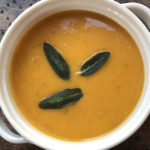Description
This vibrant, creamy soup is bursting with fall flavors and is super easy to make. Hubby loves the flavor of sage, so we worked on incorporating sage both in the cooking phase and in the garnish, and we love the results.
While I usually roast halved butternut squash fresh from the farm, you can also use pre-cut squash you can purchase at most grocery stores these days.
During this time of year, we also usually have a ton of apples, so super happy to incorporate some apple in this soup as well. It’s not really a flavor you notice or can identify in the soup, but it certainly adds a bit of sweetness and acidity that bring the flavors together. Granny Smith apples seem to have the perfect balance of sweet and tart here, so try to use those if you can.
Ingredients
- 4 to 5 pounds butternut squash – one large or two medium squash should do it.
- Olive oil or another cooking oil or butter for brushing on the squash and sauteing
- 1 large white onion, chopped
- 1 large carrot, diced
- 3 large cloves garlic, chopped
- 1 large or 2 small Granny Smith apples, peeled, cored and chopped
- 2 Tablespoons chopped fresh sage
- 4 to 5 cups low sodium vegetable or chicken broth
- 3/4 to 1 cup canned coconut milk or 1/2 cup heavy cream, plus more for garnish if desired
- 1 to 2 teaspoons salt (start with less and add more to taste)
- 1/2 teaspoon black pepper
- A pinch (1/8 teaspoon) ground nutmeg
- 1/4 to 1/2 teaspoon ground coriander
- pinch of cayenne
- Up to a teaspoon of brown sugar if needed (optional–taste soup before adding sugar)
- Additional olive oil for frying the sage leaves
- Whole sage leaves for garnish
- Maldon sea salt flakes or Kosher salt
Instructions
- Preheat the oven to 425 degrees and line a roasting pan with foil.
- If using whole squash, Wash and cut the butternut squash in half, and scoop out the seeds and fibers in the center. Brush the cut sides lightly with olive oil, sprinkle with Kosher Salt and a bit of pepper if you like, and place on a foil-lined roasting pan.
- If using pre-cubed squash, place the squash in a foil-lined roasting pan, drizzle with a bit of olive oil and toss with Kosher salt and a bit of pepper.
- Roast the unpeeled halved squash for 45 minutes to an hour, until tender. Roast the cubed squash for 25 to 30 minutes, or until tender (timing will all depend on the size of your squash or the size of your squash cubes.
- Meanwhile, heat cooking oil or butter In a large pot over medium heat. Add chopped onion and carrots and saute, stirring often, and cook until starting to soften.
- Add sage and apple and continue to cook over medium heat until the sage is aromatic and the apple has softened.
- When the squash is tender, remove from the oven and allow to cool a bit. With a large serving spoon, scoop out the squash flesh, avoiding the peel, and add it to the onion and apple mixture.
- Add seasonings and broth and stir to combine. Turn up the heat a bit and bring the mixture to a low boil. Then reduce heat to simmer for 10 to 20 minutes, or until all vegetables are very tender.
- While soup is simmering, fry your sage leaves. Wash and dry your sage leaves thoroughly. Heat oil in a small frying pan until very hot, but not smoking. Add the sage leaves, just a few at a time, to the hot oil, and watch them closely. Remove them when you see just a bit of browning. This should take only 15 to 30 seconds. Place them on paper towels and sprinkle with Maldon sea salt flakes or Kosher salt. Set aside.
- Add coconut milk. (if using cream instead, wait until the end to add the cream).
- Puree the soup by using an immersion blender, or allow the soup to cool a bit and puree in batches in a blender such as a Vitamix. NOTE: before blending, be very careful to allow the soup to cool a bit and to blend in batches. Don’t fill to blender to capacity as the steam can cause the mixture to blow the lid off and spatter hot soup all over you and your kitchen. Not at all fun! It’s also a good idea to blend at a slower speed and leave just a bit of a gap on one side of the lid for the steam to escape. If using a blender, have another pot ready to pour the pureed soup into.
- If using heavy cream, add it now.
- Taste and correct for seasoning to your taste. Add salt, pepper, or even a tad of sugar if you feel the soup needs more of a flavor boost.
- Serve the soup topped with the crispy fried sage leaves and optional additional cream or coconut milk.
